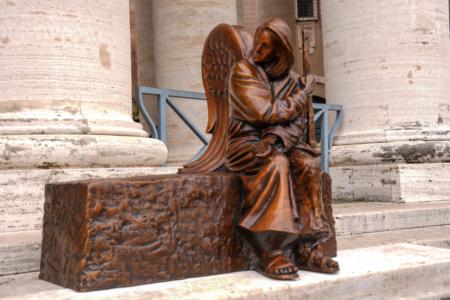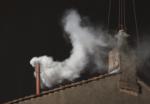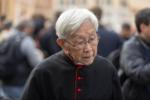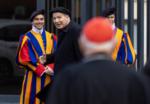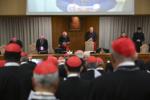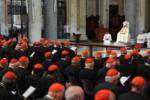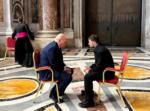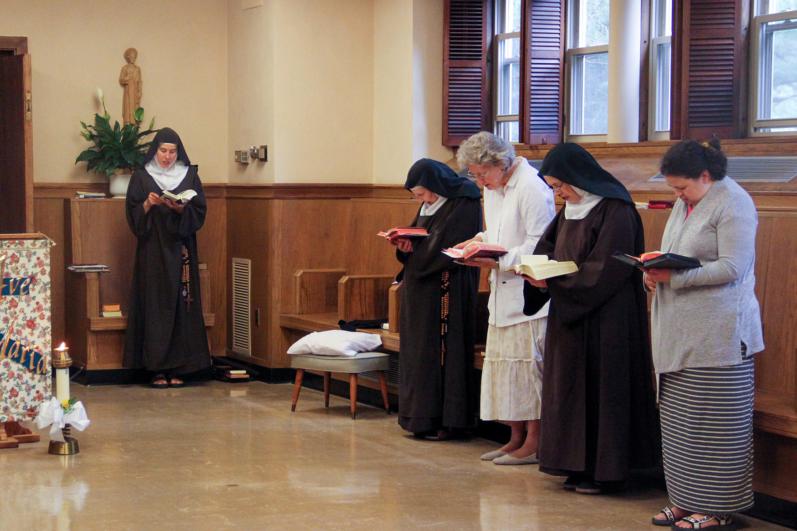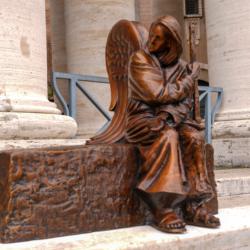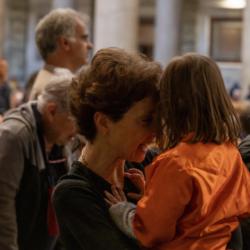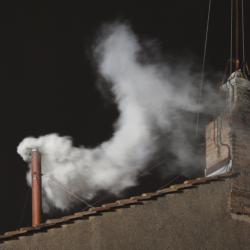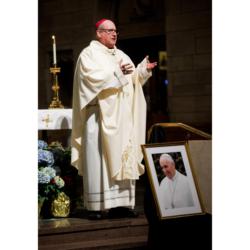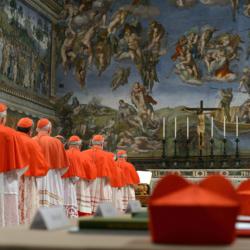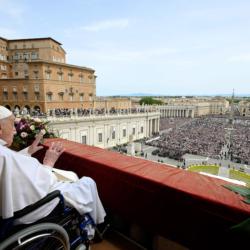Contemplative Religious Communities: The Carmelites of Danvers
DANVERS -- Half a mile away from Bishop Fenwick High School is the Monastery of St. Therese, a community of Carmelite nuns who have been a beacon of faith in the community for over 60 years.
The Pilot met with Mother Teresa Callahan, the abbess, and Sister Bernadette Desilets, the novice mistress, on May 19. At that time, Mother Teresa was battling cancer. She passed to the Lord on June 1 at the age of 79.
The Carmelite order has its roots in the Holy Land, where hermits lived on Mount Carmel in imitation of the prophet Elijah. Some European Crusaders adopted this lifestyle, but were driven back to Europe when the Saracens reclaimed the Holy Land. In the 1500s, St. Teresa of Avila and St. John of the Cross reformed the Carmelite order to return it to its original rule. The Carmelites now look to these saints as their spiritual parents.
"You have to know your parents, and your parents are going to help you," Sister Bernadette explained.
The first Carmelite foundation in the U.S. was in Port Tobacco, Maryland. The Carmelites came to the Roxbury neighborhood of Boston in 1890, and as the number of applicants grew, Cardinal Richard Cushing invited them to start another community on the North Shore.
The Danvers monastery opened in 1958 on land that had previously been a golf course. Bishop Fenwick High School was built on the other half of the property and opened a year later. The borders of Danvers, Salem, and Peabody meet on the monastery grounds.
The monastery has maintained a good relationship with the high school over the years. Students would come to ask for the sisters' prayers before important sports events. Mother Teresa said she enjoyed hearing the drum and bugle corps competitions when they took place on the school's football field.
The Monastery of St. Therese is currently home to nine sisters and two dogs. Priests from the Discalced Carmelite Fathers serve as their confessors, spiritual directors, and Mass celebrants.
St. Teresa of Avila compared Carmelite nuns to the standard bearer in an army, an unarmed soldier carrying the flag that serves as a rallying point for troops marching into battle.
"They know where they're going and what their purpose is," Mother Teresa said.
She likened that image to the symbol of the beacon on a hill in the Gospels and said they are "a sign of faith" to people who ask them for their prayers for different intentions.
"We are a rallying point for their faith, a focus, so they can know that there is a God somewhere, even if they don't have a personal experience of feeling he's close to them. Somehow, they feel that if we're close to him, they can meet him through us. So, we have a very strong purpose in just being what we are," Mother Teresa said.
She acknowledged that many people want to see tangible results of their prayers. But as contemplatives, the Carmelite nuns are called to lives of deep prayer -- partly in community and partly in solitude -- without necessarily seeing the results.
"The emphasis for us is a lot more interior prayer, silent prayer, rather than, say, liturgical prayer or hospitality to the poor," Mother Teresa said.
They gather seven times a day to pray the Divine Office together. Mother Teresa said that because it is used throughout the world, it brings "a sense of universality."
"You know you're praying not just for yourself but as a Church, as a people. So, it's a very powerful prayer," she said.
Each morning, one sister wakes the others with the sound of a wooden "clapper." They have an hour of mental prayer, followed by the Divine Office, and then a little free time before Mass.
The period after receiving the Eucharist is particularly important to Carmelites since St. Teresa considered it the most sacred time of the day. Their constitutions also encourage them to visit Jesus in the Blessed Sacrament, so they have opportunities for adoration each day.
After daily Mass, they have midmorning prayer and a simple breakfast. Then comes the morning work period. The abbess, who is elected for three years at a time, decides each person's assignment. Everyone helps in the garden if they are physically able.
They eat one full meal each day at noon. Usually, a sister is chosen each week to read aloud during the meal. They read the Bible, a section from their constitutions, and some spiritual reading chosen by the abbess. On special days, they might listen to music.
In the afternoon, they have periods for recreation, spiritual reading, and work. Sisters in the novitiate have classes. Diocesan priests also visit to teach classes on different topics.
After vespers, compline, and another hour of mental prayer, they have supper or "collation." Then they have a less formal recreation period when they can talk or do practical work like sewing. On Sundays, they might have an activity like a puzzle. They have subscriptions to a few magazines, as well as a newsletter of their association, which they pass from one sister to another.
At the end of the day, they pray the Lord's Prayer and the Hail Mary, and then the Grand Silence begins. The abbess gives a blessing to each sister, and they kiss her scapular, which Sister Bernadette said is "a sign of obedience and love of Our Lady."
Some aspects of their routine have changed as the community ages. For instance, the nightly blessing used to be given at the doors of the sisters' cells, but that became difficult for the older sisters, so now they do it in the choir. While undergoing chemotherapy, which made her more tired, Mother Teresa took to praying the Divine Office in her room.
"We try to keep the spirit of the customs but adapt to the needs," Mother Teresa said.
One sister, the last surviving foundress from the Roxbury community, died recently at the age of 97. Toward the end of her life, she was confined to a wheelchair, but her mind remained sharp, and she continued to read the works of St. John of the Cross and spiritual reading about Our Lady of Mount Carmel.
"This is something that meant a lot to the community, especially the younger ones, that someone was still so faithful to the rule, to her calling," Mother Teresa said.
When it comes to discerning a vocation, Sister Bernadette said age does not matter as much as whether the person fits the community spirit. Applicants may be in their 20s or 30s, or even in their 50s.
Mother Teresa described the latter group as a new type of applicant: "They're new to religious life, but they're not new to life." For this group, she said, it can be difficult learning to not be in control and to live with other people they might not get along with.
She acknowledged that religious life is "a difficult vocation if you're not called to it."
"Everyone has to grow in some area or other, and some in many areas. But the Lord knows how much help we need. He handpicks the ones that we're here with, at what time, so that they're just the ones that we need to help rub off some of the rough edges, or to shore us up in our weak spots, or whatever we need to draw closer to him," Mother Teresa said.
More information about the Monastery of St. Therese can be found at www.carmelofdanvers.org.
